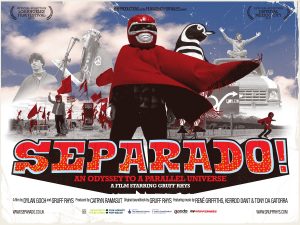-
4-minute read
-
12th October 2016
APA Referencing – Citing a Movie or TV Show
The vast majority of citations in academic writing are for books, journals and other written sources. Sometimes, however, you might need to cite a movie or TV show.

(Photo: David Shankbone/wikimedia)
Are there special rules for this, you may be wondering? You bet there are, sonny! Herein, for instance, we take a look at how to cite a motion picture or TV show with APA referencing.
Citing a Motion Picture
You might think this is only relevant if you’re studying film and media, but it can also be crucial in many subject areas (e.g., if you want to quote something from a documentary).
The in-text citation format to use here is similar to that used for print sources, except that you name the producer and director instead of the author, along with the year of release:
René Griffiths eventually found success in South America (Ramasut & Goch, 2010).
This is accompanied by full detail of the source in the reference list, using the following format:
Last Name, Initial(s). (Producer), & Last Name, Initial(s). (Director). (Year). Title [Motion picture]. Studio or distributor.
In the case of the documentary cited above, this would appear as:
Ramasut, C. (Producer), & Goch, D. (Director). (2010). Separado! [Motion picture]. Soda Pictures.
Citing a TV Show
The format for citing a TV show depends on whether it’s a one-off broadcast, a single episode of a series or a complete series. For each, however, in-text citations require you to name an authority (e.g. a director, writer or producer) and a year of broadcast:
The game itself was preceded by a six-hour pre-game show (Esocoff, 2015).
For a one-off broadcast, include the following in the reference list:
Last Name, Initial(s). (Title of Authority). (Year, Month Day). Title of show [Television broadcast]. Broadcasting Company.
Find this useful?
Subscribe to our newsletter and get writing tips from our editors straight to your inbox.
Subscribe to Beyond the Margins and get your monthly fix of editorial strategy, workflow tips, and real-world examples from content leaders.
The show cited above would therefore appear as:
Esocoff, D. (Director). (2015, February 1). Super Bowl XLIX [Television broadcast]. NBC Sports.

If you’re citing a series as a whole, the format changes slightly:
Last Name, Initial(s). (Title of Authority). (Year of First Series). Title of series [Television series]. Broadcasting Company.
When citing a particular episode, the details are included before the series information:
Last Name, Initial(s). (Writer), & Last Name, Initial(s). (Director). (Year). Title of episode [Television series episode]. In Name of Producer (Producer), Title of series. Broadcasting Company.
As such, an episode of the show Last Week Tonight would appear in the reference list as:
Avery, K. (Writer), & Perota, J. (Director). (2014). Military translators [Television series episode]. In J. Oliver (Executive Producer), Last week tonight. HBO.
Timestamps
If you’re referencing a particular section of a movie or TV show, you’ll need to include a timestamp in the citation, just as you’d give page numbers when quoting a print source. This involves indicating the time at which the relevant section begins:
Rhys ends his search at the final residence of Butch Cassidy and the Sundance Kid (Ramasut & Goch, 2010, 1:17:20).
The citation above, for instance, shows that the section in question starts at one hour, seventeen minutes and twenty seconds into the video, making it easier to find the information referenced.

(Image: Soda Pictures)




